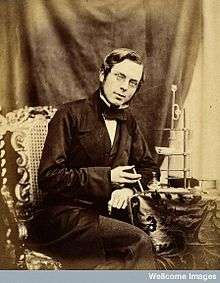Thomas Frederick Hardwich
Reverend Thomas Frederick Hardwich (18 September 1829 – 24 June 1890) was a photographic chemist, writer on photographic chemistry, demonstrator and lecturer in photography at King's College London, and the author of A Manual of Photographic Chemistry including the practice of the Collodion Process (first edition 1855 and later editions to 1883),[1] then later, curate of St John, Shildon, in the diocese of Durham.[2]

Career
Thomas Frederick Hardwich held the positions of Curator of laboratory (1850-1854); Demonstrator of Chemistry (1851-1854); and, Lecturer of Photography (1857-1860).[3] He was elected to membership of the Photographic Society (later Royal Photographic Society on 1 March 1855 and was an active participant in the Society's activities until his abrupt resignation in 1861.[4] He was also a member of the Photographic Society Club, a group of members of the Photographic Society, which formed to exchange photographs.[5] He was also an honorary member of the Photographic Society of Bombay.[6] Hardwich also formulated a popular collodion that was sold extensively and was used by the Collodion Committee of the Photographic Society.[7] He was a member of the Society's important Fading Committee which was convened at the request of Prince Albert to look at the causes and possible means of preventing the fading of photographic prints.[8]
Hardwich was also on the council of the Photographic Association which led to him resigning from the Photographic Society's council.[9]
He formed a close working relationship with the photographer Robert Howlett and Howlett's death on 2 December 1858 had a profound effect on him. Hardwich left London and took holy orders, becoming a Minister of the Church of England and wrote in 1861 that 'he will shortly enter into holy orders with a view to "spending the remainder of his life in preaching the gospel"'.[10] He was ordained as a Deacon by Lord Bishop of Durham on 10 November 1861, and became curate at the church of his father-in-law, St John's at Shildon. Hardwich wrote in 1861 that 'Photography, as you may imagine, is at a standstill' and concluded by stating that he shall always feel interested in the progress of the art.[11] In 1867 he became Rector of St. Saviour's Parish Church, Shotton Colliery, County Durham, where he remained until his death.[12]
Personal life
Hardwich was the son of Lieut. John Hardwich R.N. (1795-1846) of Westbury-sub-Mendip, Somerset and Ann Norman. He was educated at Kings School, Sherborne between 1841-1844 and then at King's College, London Medical Department (1847-1848). He matriculated in 1849-1850 and was Elected Daniell Scholar 1850; and passed the 1st M.B. Examination 1850. He married Junie Caroline Manisty (1834-1905) in 1863 at Shildon, Durham. He had six children: Junie Frances Hardwich (1864-1881),[13] Frederick Norman Hardwich (1866–1896),[14] James Edward Hardwich (1868-1913), Sarah May Hardwich (1870-1917), John Manisty Hardwich (1873-1959), Walter Henry Albert Hardwich (1876-1946).[15]
Death
He died at Shotton Vicarage, Easington, County Durham, on 24 June 1890, leaving an estate of £10,170 13s 7d.[16]
References
- Gernsheim, H. (1984), Incunabula of British Photographic Literature 1839-1875, London: Scolar Press, no. 739
- Teanby, Rose (2017),'The Two Lives of Thomas Frederick Hardwich (1929-1890)' http://www.photohistories.com/Photo-Histories/75/the-two-lives-of-thomas-frederick-hardwich-1829-1890 Accessed 2 May 2017.
- Hardwich is sometimes described as 'Professor of Photography at King's College, London, but no evidence of this appointment has been found. In his own publications he is only described as 'late demonstrator of chemistry and lecturer on photography' (1861). The error seems to have arisen in a notice of his death given in British Journal Photographic Almanac 1891, p.476.
- 'Members of The Royal Photographic Society 1853-1901 http://rpsmembers.dmu.ac.uk/rps_results.php?mid=801 Accessed 2 May 2017.
- Taylor, Roger, Impressed by Light. British Photographs form Paper Negatives, 1840-1860, pp. 84-86.
- Taylor, Roger, Impressed by Light. British Photographs form Paper Negatives, 1840-1860, pp. 410, n.28.
- Baldwin, G. et. al. (2004), All the Mighty World. The Photographs of Roger Fenton, 1852-1860, London: Yale University Press, pp. 206, 236.
- Delamotte et al, 'First Report of the Committee Appointed to Take into Consideration the Question of the Fading of Positive Photographic Pictures upon Paper', Journal of the Photographic Society, v.2 (21 November 1855), pp. 251-52.
- Baldwin, G. et. al. (2004), All the Mighty World. The Photographs of Roger Fenton, 1852-1860, London: Yale University Press, pp. 236; Journal of the Photographic Society, no. 42 (21 May 1856), p.37
- Photographic News 9 August 1861.
- Photographic News 9 August 1861.
- 'Hardwich, Thomas Frederick', http://www.kingscollections.org/victorianlives/g-i/hardwich-thomas-frederick, Accessed 2 May 2017.
- Her death certificate refers to her as June Frances Hardwich, although her birth certificate calls her Junie Caroline Hardwich.
- Register of Births in the sub-district of Easington, Durham, 1868 no. 185.
- 'Hardwich, Thomas Frederick', http://www.kingscollections.org/victorianlives/g-i/hardwich-thomas-frederick, Accessed 2 May 2017; and birth and death registers, England and Wales.
- 'Hardwich, Thomas Frederick', http://www.kingscollections.org/victorianlives/g-i/hardwich-thomas-frederick, Accessed 2 May 2017.